
In our quest to find the answer to this inquiry, let’s commence with the celestial body we are most familiar with – our Sun!
Owing to the Earth’s atmosphere, we perceive our Sun as a shade of yellow and occasionally red or even orange! Nevertheless, its actual hue is white or a shade close to white.
One captivating tidbit concerning the color of our Sun is that it will not remain the same indefinitely. Eventually, in the distant future, when the Sun depletes its hydrogen (its source of fuel), it will progress into the red giant stage. As the name suggests, it will physically expand into a colossal red star poised to erupt!
What is the impact of temperature on the color of a star?
So, what factors influence the color of a star? Temperature plays a significant role. As a star reaches the end of its life cycle, its temperature decreases as it runs out of fuel. This decrease in energy production leads to a lower frequency of emitted light, which falls within the red portion of the visible spectrum. Consequently, when a star cools down, its radiation shifts towards the red end.
You might be curious, does red signify cold while blue signifies hot? The hottest stars appear blue due to their radiation being more concentrated in the blue part of the spectrum.
The correlation between temperature and emitted radiation is a critical and unique attribute of stars, which led astronomers Einar Hertzsprung and Henry Norris Russell to develop an independent classification system for stars based on this factor in the 1900s. They represented this relationship graphically in the Hertzsprung-Russell diagram, which plots temperature against the luminosity or color of the star.
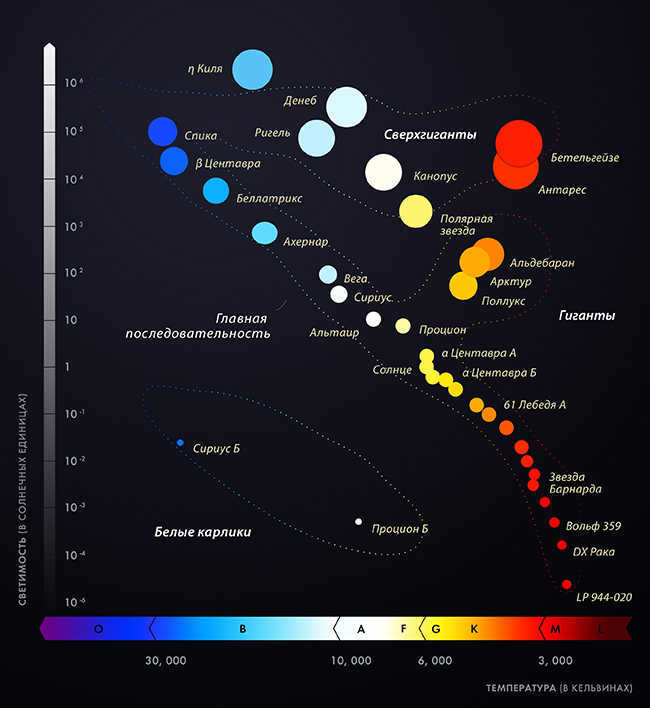
By observing this chart, we can easily observe a clear outcome – the association between temperature and hue. Stars with higher temperatures are positioned in the blue section of the chart, while stars with lower temperatures are situated in the red section. This chart not only aids in categorizing stars, but it also contributes to our comprehension of their development, making it tremendously significant.
Temperature is not the sole determinant of a star’s color, as there are other factors at play. We are aware that our Sun and all the stars we observe in the night sky are moving at high velocities within our galaxy.
Interestingly, some stars may be moving away from us, while others may be moving closer. Surprisingly, this motion also influences the color of these stars.
When a star is moving away from us, the light it emits shifts towards the red end of the spectrum. Conversely, if a star is moving towards us, its light shifts towards the blue end of the spectrum. This phenomenon is known as the Doppler effect and holds great significance in the interpretation of telescope images.
However, there is yet another crucial factor that impacts a star’s color: its composition. Simply put, the various elements present within a star contribute to its coloration!
What is the mechanism behind a star’s color due to its composition?
By examining the image displayed below, one can witness the captivating display of flames in various hues. The reason behind these vibrant colors lies in the combustion of diverse metals present in the atmosphere. As each flame emits radiation at a specific frequency or wavelength, their distinct coloring serves as a distinguishing characteristic for the individual metals, facilitating their identification through spectroscopy. Furthermore, this phenomenon occasionally imparts a chromatic essence to celestial bodies known as stars.

Let’s make it clear. The combustion process that occurs on Earth is not the same as the one that takes place in stars. However, the radiation emitted by stars is still unique to them, and we can use the frequencies of this emission to determine which metal is being consumed, created, or simply present within stars.
This information also helps us gain insight into the stage of a star’s life cycle. As the star ages and all the hydrogen is depleted through nuclear fusion, heavier metals begin to form.
The initial stars in the cosmos lacked any metals at their formation. They were composed solely of hydrogen. Other metals were produced within these stars as they consumed their fuel. And when they perished and dispersed their metals into space, those metals became part of the fundamental components for the succeeding generation of stars. Consequently, successor stars will possess a higher metal content than their precursor stars. This is a significant concept when examining the chronology of galaxies.
Now, you might be pondering why we do not observe colors, like the green flame in the depicted image, in any of the stars in the nocturnal sky. Well, that is a completely legitimate question. To address this, we will refer back to the statement made earlier in this article. Recall that the color of the Sun was essentially white or close to white.
The Sun emits radiation in all colors of the visible spectrum, with a slight preference for green. Consequently, the radiation from the Sun contains more green than any other color. Thus, one might expect the Sun to appear green.
However, the reality is that green lies in the middle of the visible spectrum. It is surrounded by other colors and is composed of a combination of these colors. Therefore, in order for green to be perceived as a distinct color, it must be isolated. In space, where the Sun’s radiation is accompanied by emissions of other colors, we perceive it more as white (a blend of all colors) rather than green. On Earth, due to our atmosphere, the Sun appears yellow.
Similarly, the reason we are unable to perceive green stars is because the green radiation they emit is accompanied by other colors that combine to form white light. It is important to note that green is not the only color for which stars are invisible to us. There are several other colors, particularly those that are close to the blue end of the spectrum, such as violet and magenta, that we are unable to see due to the fact that our eyes are more sensitive to blue light and perceive these colors as blue.
The color of stars is determined by their temperature and mass. This process begins at the moment of their birth, which occurs when a nebula condenses and undergoes nuclear fusion.
The color of a star is established during this initial stage and continues until the star has depleted all of its fuel or energy, which consists of a combination of hydrogen and helium. This birth process can span thousands or even millions of years.
Stars exhibit a variety of colors, providing insight into their estimated age. Take, for instance, the Sun, which boasts a yellowish hue; from this, one can deduce that it possesses an average age.
The Sun falls within the range of 4,000 to 4.6 billion years old, with a temperature hovering around 6,000 °C.
Typically, the youngest stars burn the hottest, with temperatures soaring up to 40,000 °C. Conversely, the oldest stars boast cooler temperatures, reaching approximately 3,000 °C, and display a reddish tint.
Categories of stars based on their color
1- Blue stars.
Blue stars are among the youngest in the universe. Their color is determined by their temperature, which happens to be some of the hottest.
An excellent example of a blue star is Alnilam. It boasts a scorching temperature of 27,000 ° C and shines with a brightness equivalent to 375,000 suns.
Alnilam is particularly famous because it forms part of Orion’s belt, alongside two other stars named Alnitak and Mintaka.
2- White stars.
White stars are characterized by their intense heat and ultraviolet color. Despite their actual color, which is ultraviolet, they appear white to the human eye. This is because they emit all the colors of the color spectrum along with UV rays.
One example of a white star is Spica, also known as Spike. It is part of the Virgo constellation and has a temperature ranging from 22,400 ° C to 18,500 ° C. Notably, Spica is larger than the Sun.
Yellow stars have a similar appearance to the Sun and have a temperature of 6,000 ° C. They typically have an average age that ranges between 4 and 10 billion years.
A yellow star’s lifespan lasts for approximately 12 billion years, after which it begins the transformation into either an orange or red star.
One of the most well-known yellow stars is our very own Sun. Another notable yellow star is Helvetzios, which belongs to the constellation Pegasus and has a temperature of 5517 ° C, making it a solar-type star.
4-Orange stars
Orange stars are characterized by their temperature, which falls within the range of 4000 ° C. While some orange dwarfs may have temperatures below 4000 °C, they are still classified as orange stars due to their distinct color and brightness.
For instance, let’s consider Arthur’s star, which shines with an orange hue. Not only is it the brightest star visible in the night sky, but it is also the second brightest star known to astronomers.
Arthur’s star has a scorching temperature of 4290 ° C and can be found in the constellation El Boyero.
5- Scarlet stars.
This is the final hue of stars. The reason behind this is their energy depletion reaching a near-complete state.
Compared to the other stars, these stars have a considerably lower temperature: it hovers around 3000 ° C.
Betelgeuse is a scarlet star that belongs to the Orion constellation. Its temperature varies between 3500 and 3000 ° C, making it the most luminous star in its constellation.
The primary determinant of a star’s color is its surface temperature. Blue stars are the hottest, while red stars are the coolest. Additionally, smaller stars tend to be colder, while larger stars are hotter and heavier. Stars with a mass less than 0.08 solar masses do not reach full star status and are known as brown dwarfs. Stars with a mass of up to 0.5 solar masses are called red dwarfs, which are small, dim, and have exceptionally long lifespans.
The sun, along with stars of similar mass and age, falls into the category of yellow dwarfs. On the other hand, stars with a mass of 8 solar masses or more are classified as giants or supergiants. These stars are rare and have relatively short lifespans, but they are highly visible in the night sky. They also produce the majority of ionizing radiation and heavy elements in the universe. Ultimately, these massive stars explode in supernovae and give rise to neutron stars and black holes.
A star’s color changes as it ages. Although our Sun is currently a yellow dwarf, it will eventually transform into a red giant after approximately 5 billion more years. Eventually, it will shed its outer layers (briefly turning large and pale blue) and become a slowly cooling white dwarf.
The Main Sequence illustrates the relationship between a star’s color, temperature, and mass.
The major factor is the surface temperature. The Sun has a temperature of 6,000 Kelvin. In reality, the Sun is white in color, but when observed from Earth, it appears yellow due to the light passing through the atmosphere. If the temperature was lower, the light would appear red, and if it was higher, it would appear blue. The figure below illustrates the relationship between temperature and stellar color, along with the colors of different stars.
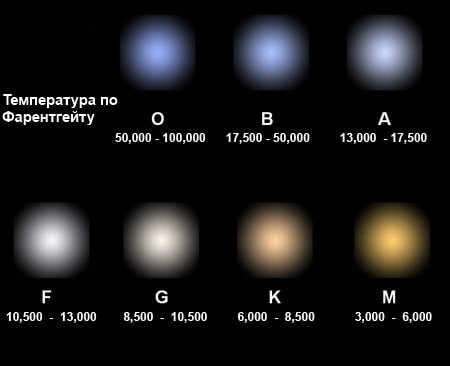
The color of a star changes depending on the temperature of its surface
Therefore, it is understood that red dwarfs are the coldest stars. They have a mass that can only reach up to 7.5% of the solar mass, and their surface temperature is around 3500 Kelvin. While they may have various colors, our eyes perceive the most dominant one – red.
Red giants also exhibit a red color. These stars have the same mass as the Sun and have consumed all of their hydrogen, causing them to expand in size. As a result, their surface area increases and their temperature decreases.
The coldest stars have surface temperatures that are considerably lower than those of the hottest celestial bodies. Blue stars are the hottest and can have temperatures of 10000 Kelvin, while hypergiants can reach even higher temperatures of 40000 Kelvin. Understanding the variations in stellar coloration allows for the classification of different types of celestial bodies.
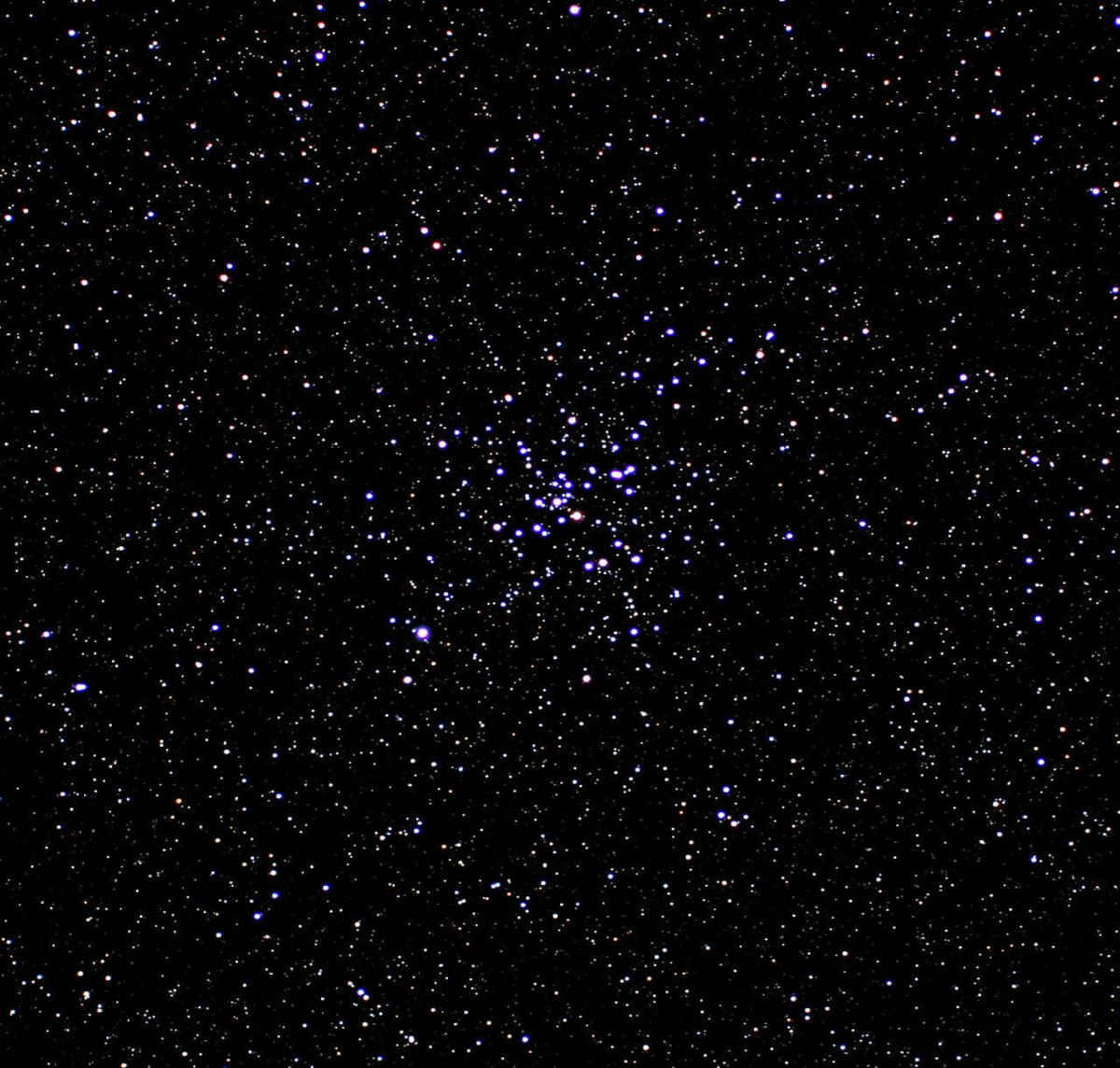
Variations in star hue
Disparities in the hue of stars are a result of their distinct temperatures. Let’s delve into what causes this phenomenon. Light is a form of wave radiation. The span between the peaks of a single wave is referred to as its wavelength. Light waves are incredibly short. How short, you may ask? Imagine dividing an inch into 250,000 equal sections (1 inch equals 2.54 centimeters). A handful of these sections would constitute the length of a single light wavelength.
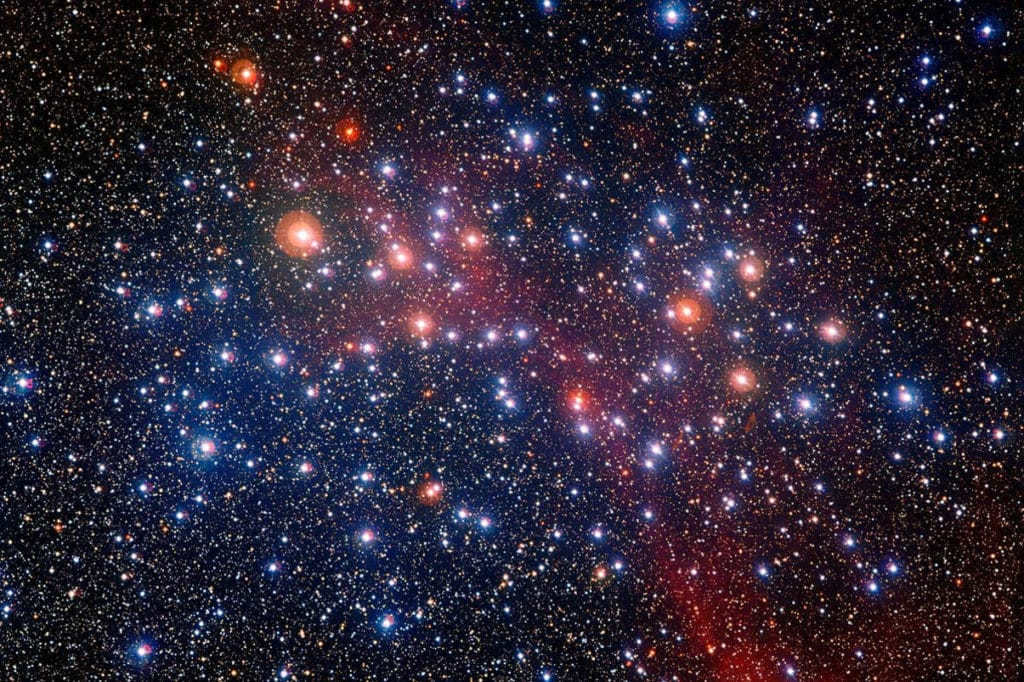
Despite the extremely small wavelength of light, even the slightest variation in the size of the light waves can have a profound impact on the color of the image we perceive. This is because our eyes perceive light waves of different wavelengths as different colors. For instance, the wavelength of red light is one and a half times longer than the wavelength of blue light. When combined, these different wavelengths create white light, which is composed of photons of various colors.
Through our daily experiences, we understand that the color of objects is influenced by their temperature. Take, for example, an iron poker placed in a fire. As it heats up, the color of the poker will shift from red to a deeper shade of red. If the poker could withstand further heating without melting, it would transition from red to orange, then yellow, and eventually to white. At its highest temperature, the poker would emit a blue-white hue.
The sun is a yellow star. Its surface temperature is 5,500 degrees Celsius. The hottest blue star’s surface temperature exceeds 33,000 degrees Celsius.
The relationship between color and temperature
Scientists have established physical laws that connect color and temperature. The higher the temperature of an object, the more energy it emits from its surface, resulting in shorter wavelengths. Blue light has a shorter wavelength compared to red light. Consequently, if an object emits light in the blue wavelength range, it is hotter than an object emitting red light. Stars’ glowing gas atoms release particles called photons. The hotter the gas, the higher the energy and shorter the wavelength of the photons.
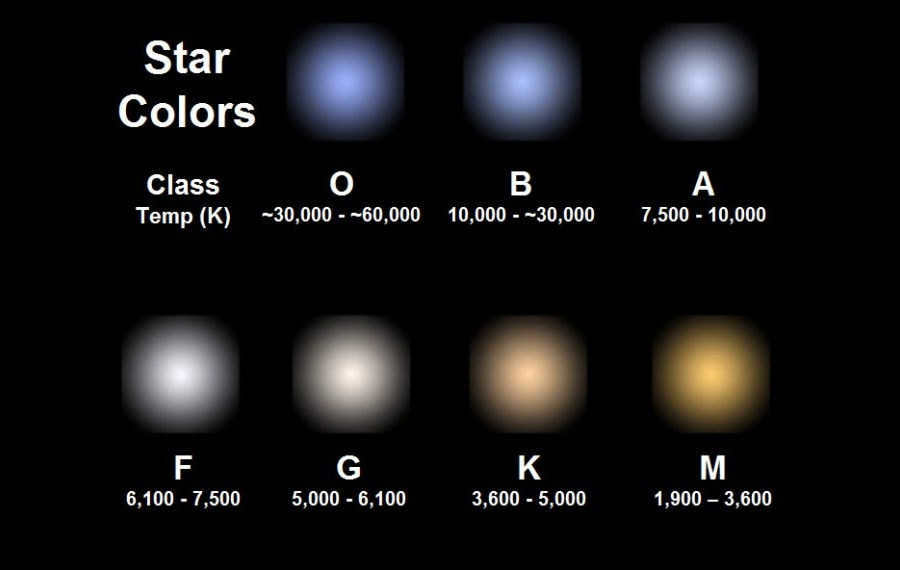
This is the reason why the most recent and hottest stars emit light in the range of blue and white. As stars consume their nuclear fuel, they gradually cool down. This is why older stars that are cooling emit light in the red part of the spectrum. Stars that are in the middle of their lifecycle, like our Sun, emit light in the yellow part of the spectrum.
Our Sun is located 149 million kilometers away from Earth, which allows us to clearly observe its color. However, other stars are trillions of kilometers or even further away from us. Even with the use of powerful telescopes, it is impossible to determine their color with absolute certainty. To obtain this information, scientists make use of a specialized device called a spectrograph, which allows them to analyze the spectral composition of starlight.
The determination of a star’s age through its color
Astronomers ascertain the color of a star based on the most concentrated radiation in its spectrum. By employing straightforward mathematical equations, one can deduce the surface temperature of the star from its color. Consequently, the age of the star can be inferred from its temperature.
Fascinating video on the hues of stars
In case you stumble upon any inaccuracies, kindly select the specific text and press Ctrl+Enter.
The arrangement of stars in the celestial sphere remains relatively constant, in contrast to the more noticeable motion of planets. To observe the changing positions of stars, one must observe them over the course of millennia. The precise total number of stars in the Universe remains unknown, and even with the most advanced astronomical instruments, astronomers may never be able to accurately count them. However, on a moonless night in the countryside, away from light pollution, the naked eye can perceive approximately 3000 stars in the night sky.
The illusion of countless stars is further reinforced by their twinkling. The brightness and color of stars appear to be in constant flux, as if they are trembling. This phenomenon is caused by the movement of air masses between the stars and us. There are certain variable stars whose brightness fluctuates periodically according to specific laws. However, the majority of stars maintain a consistent radiance over an extended period of time.
The temperature of a star’s surface is primarily reflected by its color. Blue stars are the hottest, while red stars are the coolest. Generally, smaller stars are colder, while larger stars are hotter and heavier. Stars with a mass less than 0.08 solar masses do not become full-fledged stars and are known as brown dwarfs, whereas stars with a mass up to 0.5 solar masses become red dwarfs. Red dwarfs are small, dim, and have a long lifespan.
The sun, as well as stars with similar mass and age, is classified as a yellow dwarf. Giants and supergiants are the designation given to stars with a mass of 8 solar masses or more. These stars are rare, have a short lifespan, and are highly visible in the sky. They produce the majority of ionizing radiation and heavy elements in the universe. Eventually, these stars explode in supernovae and give rise to neutron stars and black holes.
A star’s color changes as it ages. For example, our Sun will not always be a yellow dwarf. It will continue to shine for approximately 5 billion more years, and as it nears the end of its life, it will expand and become a red giant. Eventually, the Sun will shed its outer layers, briefly turning blue before settling into a slowly cooling white dwarf.
The Main Sequence illustrates the relationship between a star’s color, temperature, and mass.
Stars exhibit a wide range of colors, ranging from yellow to almost white, blue to reddish. Even without the aid of a telescope, one can observe these variations. However, through a powerful telescope, one can discern even more subtle shades. What’s more intriguing is that many stars have the ability to change their colors. For instance, the blue star Sirius can abruptly appear deep blue or pale greenish to the observer. Is this a mere optical illusion or a genuine shift in color? Furthermore, why do stars flicker with varying frequencies and intensities, displaying a multitude of hues?
What factors determine the color of a star?
First and foremost, it is important to understand the nature of a star. Simply put, it is a celestial object composed of glowing gas or plasma. One of the key factors that remains constant for stars is their temperature. This temperature ultimately determines the color of a star.
When a body is heated, it emits light, and the wavelength of this light will vary depending on the temperature. These differences in wavelength are perceived by the human eye as different colors, ranging from red to violet. Therefore, we observe stars in various colors because they are heated to different temperatures:
What causes the variation in colors when stars twinkle
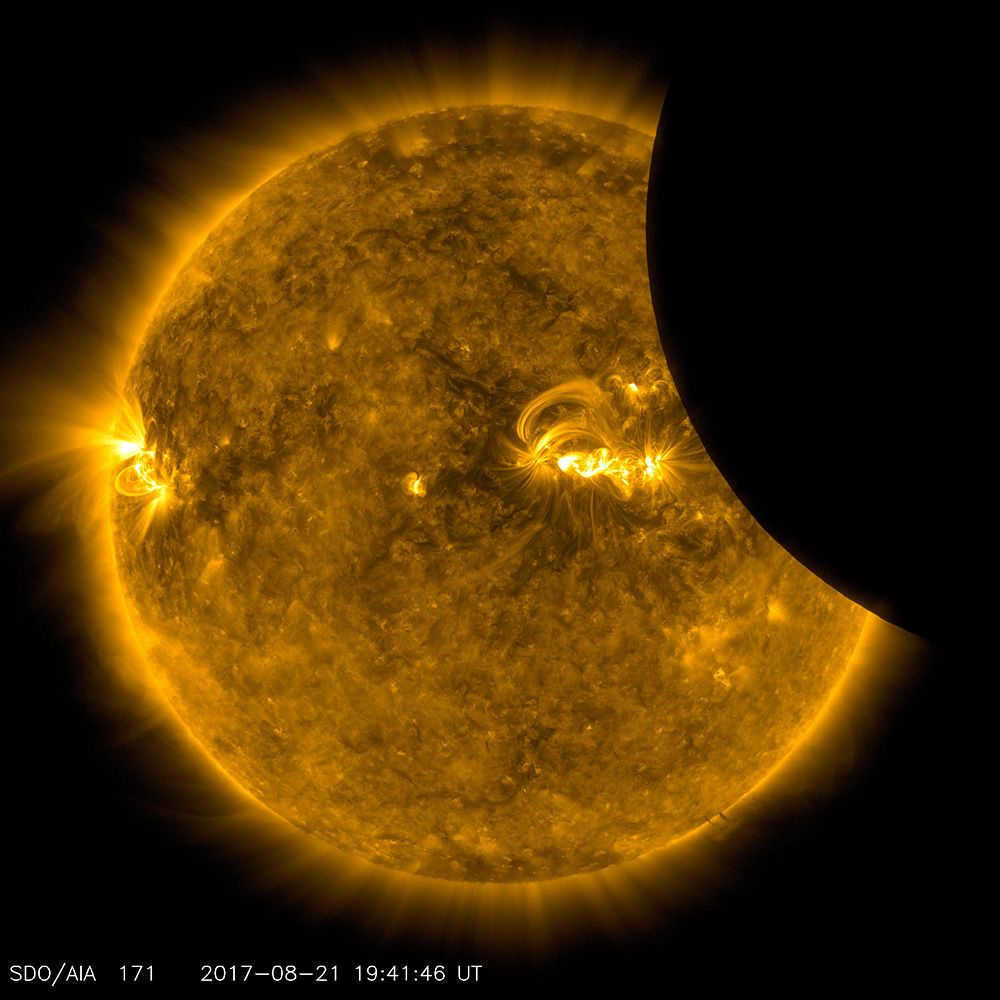

When stars emit light, their colors can vary due to a variety of factors. The Sun, for example, has a surface temperature of 5780 K, which gives it a yellow spectrum. This phenomenon is known as the Moon’s transit across the solar disk. To learn more about this fascinating process, visit nasa.gov.
It’s important to note that the manufacturer may modify the price, lineup, and specifications of their products or even discontinue them without prior notice. Be sure to stay updated on any changes through official channels.



Additional telescope and astronomy reviews and articles:
Reviews of optical equipment and accessories:
Articles about telescopes. Tips on how to select, set up, and conduct your initial observations:
The hue of stars is influenced by their temperature and mass. This process commences during their formation, when the nebula condenses and triggers nuclear fusion.
The color persists until the star has depleted all of its hydrogen and helium fuel or energy. This birth phase can span thousands or millions of years.
Stars exhibit a variety of colors, which can provide insight into their approximate age. For instance, the Sun is classified as a yellow star, indicating it has a moderate age.
The Sun is estimated to be between 4.0 and 4.6 billion years old and has a temperature of approximately 6,000°C.
The hottest stars are typically the youngest, with temperatures reaching up to 40,000 ° C. On the other hand, the oldest stars have lower temperatures, around 3,000 ° C, and they tend to have a reddish hue.
Classification of Stars by Color
1- Blue Stars
Blue stars are some of the youngest stars in the universe. Their color is determined by their high temperatures, which make them some of the hottest stars out there.
One example of a blue star is Alnilam, which has a temperature of 27,000 °C and shines with a brightness equivalent to 375,000 suns.
Alnilam is famous for being part of Orion’s belt, along with two other stars called Alnitak and Mintaka.
2- White stars.
White stars are characterized by their high temperature and their color, which appears as ultraviolet to the human eye. This color is the combination of all the colors in the spectrum, including UV rays.
One example of a white star is Spica, also known as Spike. It belongs to the Virgo constellation and has a temperature ranging from 22,400 °C to 18,500 °C. In addition, Spica is larger than the Sun.
3- Golden stars
Golden stars bear resemblance to the Sun and have a temperature of around 6,000 ° C. Their average lifespan falls between 4 and 10 billion years.
A golden star’s lifespan typically lasts about 12 billion years, at which point it undergoes a transformation into an orange or red star.
One of the most renowned stars, the Sun, is classified as a golden star. Another notable golden star is Helvetzios, with a temperature of 5517°C. It belongs to the Pegasus constellation and has a solar type classification.
4-Orange stars
Orange stars are characterized by temperatures ranging around 4000 ° C. While it’s possible for orange dwarfs to have temperatures below 4000 ° C, they are still classified as part of this group due to their distinct color and brightness.
Take Arthur’s star, for instance, which exhibits an orange hue. Not only is it the most luminous star in the night sky, but it also ranks as the second brightest star ever discovered.
With a temperature of 4290 ° C, Arthur’s star can be found within the constellation El Boyero.
This is the final hue observed in celestial bodies. This phenomenon occurs when stars have nearly depleted their energy reserves.
Compared to other stars, these celestial bodies have a significantly lower temperature, measuring around 3000 °C.
One example of such a star is Betelgeuse, which appears red in color and belongs to the Orion constellation. The temperature of Betelgeuse ranges from 3500 to 3000 °C, making it the most luminous star within its constellation.

If you were to engage in the profession of stargazing, you would swiftly observe that the stars are not as bright as one might presume.
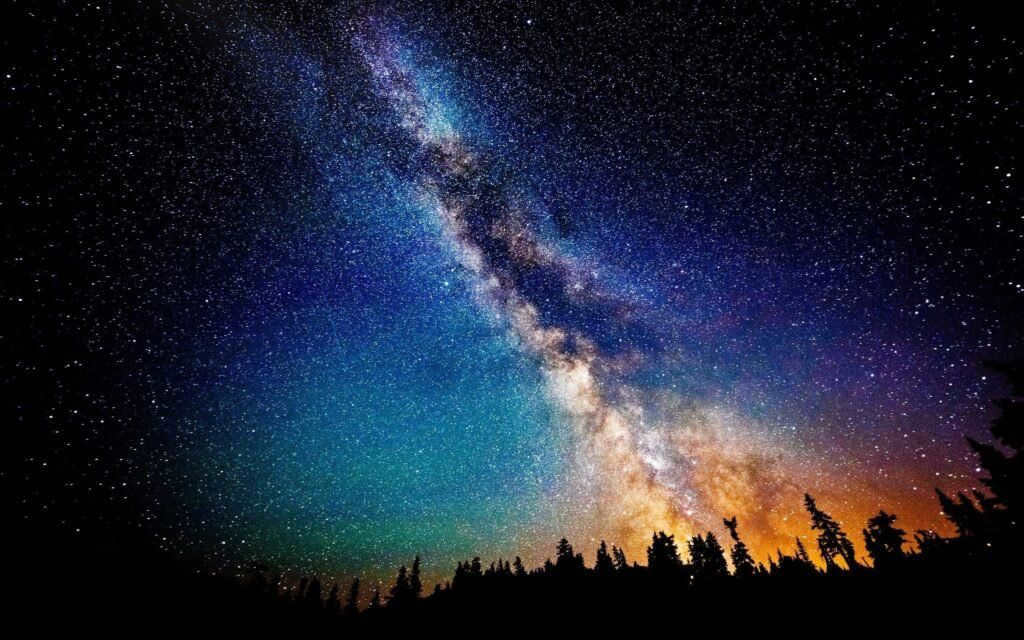
Upon closer inspection, it becomes apparent that the stars visible in the nocturnal sky can be categorized into various groups based on their distinct hues.
The hue of a star indicates the heat of its surface
Observing the celestial expanse, we can discern up to 4,548 stars with the naked eye, each exhibiting a unique shade. Further examination of star spectra can unveil intricate particulars concerning the characteristics of each individual celestial body: its temperature, proximity to Earth, luminosity (brightness), mass, and age.
Stars imitate the behavior of red-hot iron
Stars roughly imitate the physics of radiation from a black body, like an iron rod, for instance. As the temperature increases, the metal changes its color from red to orange, yellow, white, and eventually blue. The blue giants, which are the hottest stars in the Universe and have the highest luminosity, serve as a perfect example. Rigel, located in the Orion constellation, is a blue giant star that has a luminosity at least 61,500 times greater than the Sun!
The following spectral classes can be used to categorize stars according to their temperature, arranged from hottest to coldest:
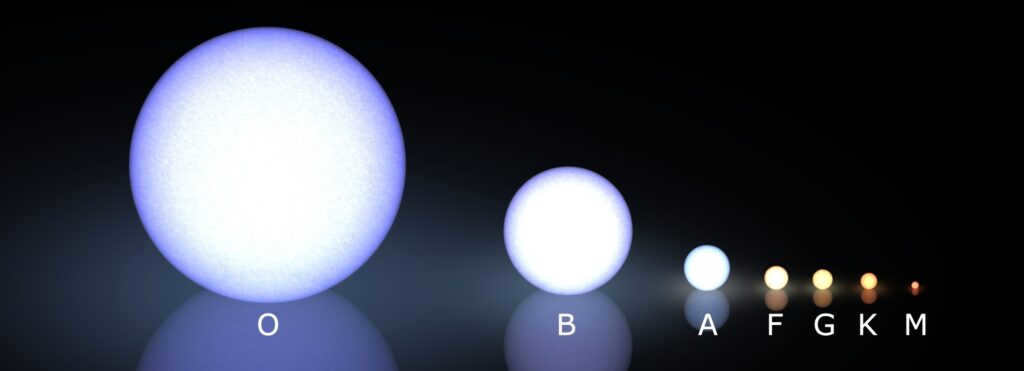
- Stars of type O appear blue in color.
- Stars of type B appear blue-white in color.
- Stars of type A appear white in color.
- Stars of type F appear yellow-white in color.
- Stars of type G appear yellow in color.
- Stars of type K appear orange in color.
- Stars of type M appear red-orange in color.
Moreover, these categories are further designated with numbers ranging from 0 to 9, with 0 denoting the hottest star and 9 denoting the coolest star. For instance, our Sun is classified as a G2 yellow dwarf.
The majority of stars in the cosmos fall into the cooler K and M categories
To be more precise, approximately 88% of the stars in the Universe belong to these specific spectral classes. Only 8% of the known stars fall into the G category, which includes our Sun. On the other hand, class O stars are incredibly rare, with an average of just one class O star for every three million stars.
There’s even more fascination beyond the optical range
The visible color of stars has categorized them into seven primary spectral classes. However, the actual spectrum stretches far beyond the range of colors that our eyes can perceive. For instance, neutron stars predominantly emit X-rays.
To us, green stars appear white, and violet stars will seem blue. It’s quite astonishing how limited the human eye is as a scientific tool.
The color of a star changes as it goes through its life cycle, depending on its initial mass and the stage of burning the elements it uses as nuclear fuel and produces during stellar nucleosynthesis.
The Winter Circle showcases the diverse colors of stars
The Winter Circle is a seasonal asterism (a group of stars with a distinct name) located in the equatorial part of the sky that is most visible in winter, late fall, and early spring.
Within the winter circle, which includes six constellations, there are several stars of different colors. The winter circle is made up of the following eight stars, each with its own unique color:
- Rigel in Orion – a blue-white supergiant located 900 light-years away.
- Procyon in the Lesser Dog – a yellow-white star located 11.4 light-years away.
- The Capella star system, located 42.2 light-years away, is a magnificent yellow giant.
- Wolopas is home to the Arcturus star, a vibrant orange giant situated 34 light-years from our planet.
- In the Gemini constellation, you’ll find the Castor and Pollux stars. Castor is a white star positioned 33.7 light-years away, while Pollux is an orange star situated 52 light-years from Earth.
- Taurus is graced by the presence of Aldebaran, a captivating orange-red giant located 65 light-years away.
- The Orion constellation boasts the illustrious Betelgeuse star. This red supergiant is a staggering 642.5 light years from our planet.
Have you ever taken a moment to appreciate the tranquility and beauty of the starry sky? It has a way of filling us with a sense of peaceful awe.
It appears that the vastness of the cosmos immerses you in an indescribable state, attempting to convey a significant message, reminding you of your inherent connection with it. The celestial bodies gleam serenely and tenderly, seemingly comprehendingly, in a familiar manner, playfully signaling. They extend an invitation for you to embark on a cosmic voyage.

What causes the twinkling of starlight?
Stars are enormous celestial bodies located millions of light years away from our planet. As a result, when we observe them, they appear as tiny specks of light. Composed primarily of gas, stars have a spherical shape with rough and jagged edges.
Deep within a star, a thermonuclear reaction occurs, generating intense heat that causes the celestial body’s gas composition to emit light. This light is so powerful that it can travel vast distances across the cosmos, allowing us to perceive it.
In reality, the light emitted by stars remains relatively constant and consistent. However, when observed from Earth, we experience the illusion of twinkling. This is due to the rays of starlight passing through our planet’s atmosphere, which acts as a barrier between us and the vastness of space.
If you were to observe the stars from a spacecraft, the Moon, or any other planet lacking an atmosphere, you would notice that their radiance appears seamless and unbroken. In an effort to minimize the interference caused by blinking, esteemed scientific observatories make a concerted effort to establish their facilities at the highest possible altitudes within mountainous regions, where the atmospheric layers are less compact.
Why do stars emit different colors?
Anyone who enjoys stargazing has surely noticed that the night sky is not only filled with twinkling lights, but also a symphony of colors. From our vantage point on Earth, we see stars flickering in various hues: blue, red, white, and even yellowish. It is even possible for a single star to appear to “wink” different colors to different observers.
This mesmerizing display of colors is the result of several factors aligning perfectly.
Relationship between a star’s color and its temperature and age
Stars exhibit a variety of colors, which are determined by the intensity and temperature of their thermonuclear reactions. As the temperature increases, the color of the celestial body tends to become closer to white or blue.
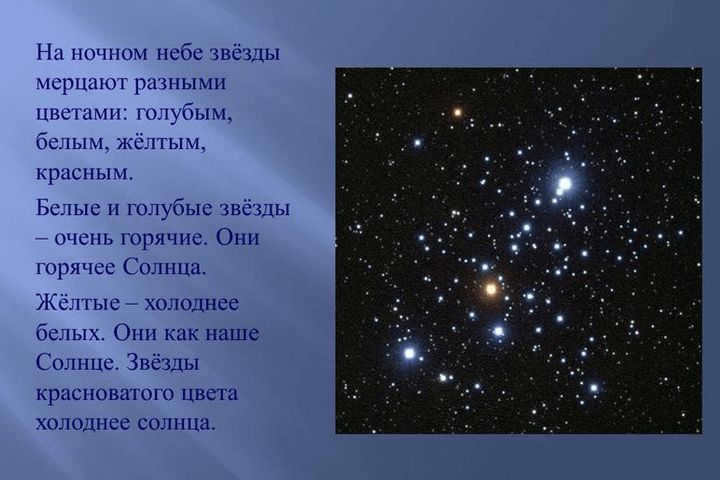
The lowest temperature stars are red. The process of changing colors can be observed when heating metal. Depending on the level of heat, the metal will transition from red to white as it reaches its highest temperature.
Astronomers have developed the ability to determine the age of stars based on their temperature and color. A star’s lifespan is limited. It begins with an explosion (during which it reaches its highest temperature) and emits a white or blue light.
As the intensity of reactions gradually decreases, the star’s color shifts and it emits a yellowish glow, eventually transitioning to shades of red towards the end of its cycle. The color of our main source of life on Earth, the Sun, is currently a light yellow. This indicates that it is in its middle age, like a “lady” in her prime.
Furthermore, our atmosphere exhibits not only heterogeneity in density, but also mobility. Within it, there are continuous movements, including the shifting of layers and the formation of various air currents. As a result, it not only causes interruptions and flickering of light rays.
Moreover, its dynamic composition scatters and separates the emitted light into different spectra, effectively refracting them. This phenomenon can be likened to the function of a curved lens, where the degree of curvature is constantly changing. Consequently, when we gaze at the dazzling stars in the night sky, we are essentially looking through a vast, ever-moving “lens”.
Why do planets not twinkle?
Unlike stars, planets do not twinkle in the sky. They emit a steady, constant glow. This is because planets have a different composition and shape compared to stars.
Planets are not gaseous like stars, but rather dense. This allows them to maintain clear, even edges and not have their contours blurred. They are also easily distinguishable as they appear as luminous disks rather than mere points of light.
So where does the light from planets come from? Planets themselves do not emit light, but instead reflect the sunlight they receive from a nearby star. In our solar system, this star is the Sun. Additionally, planets are much closer to Earth’s surface compared to stars. As a result, the Earth’s atmosphere acts as a lens, magnifying the size of planets and preventing them from flickering.
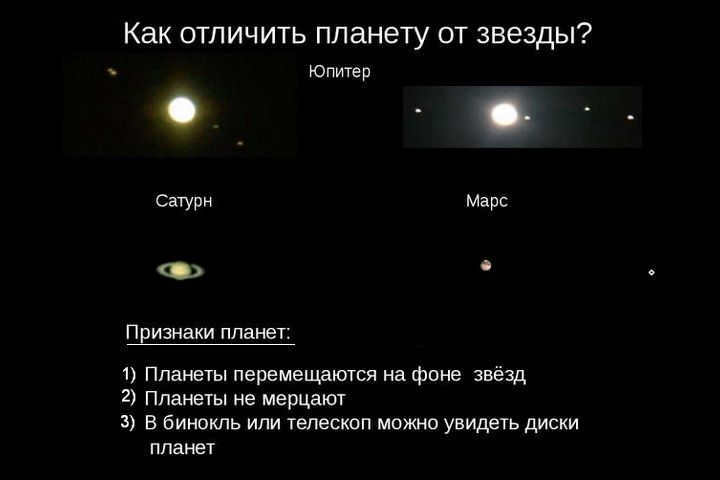
What are the planets that can be observed from Earth without using a telescope?
Venus and Jupiter are the most prominent planets that can be seen without the need for any special equipment. Venus, being the brightest, is highly visible during dawn and evening, while Jupiter appears slightly paler. Both planets appear yellow in color.
Occasionally, one may also catch a glimpse of Mars, which appears as a small, glowing red disk in the sky. However, the rest of the planets in our solar system can only be observed using powerful telescopes.
To marvel at the distant yet radiant stars, all one needs is clear weather. Their twinkling becomes particularly striking and noticeable on chilly nights or after rainfall.





